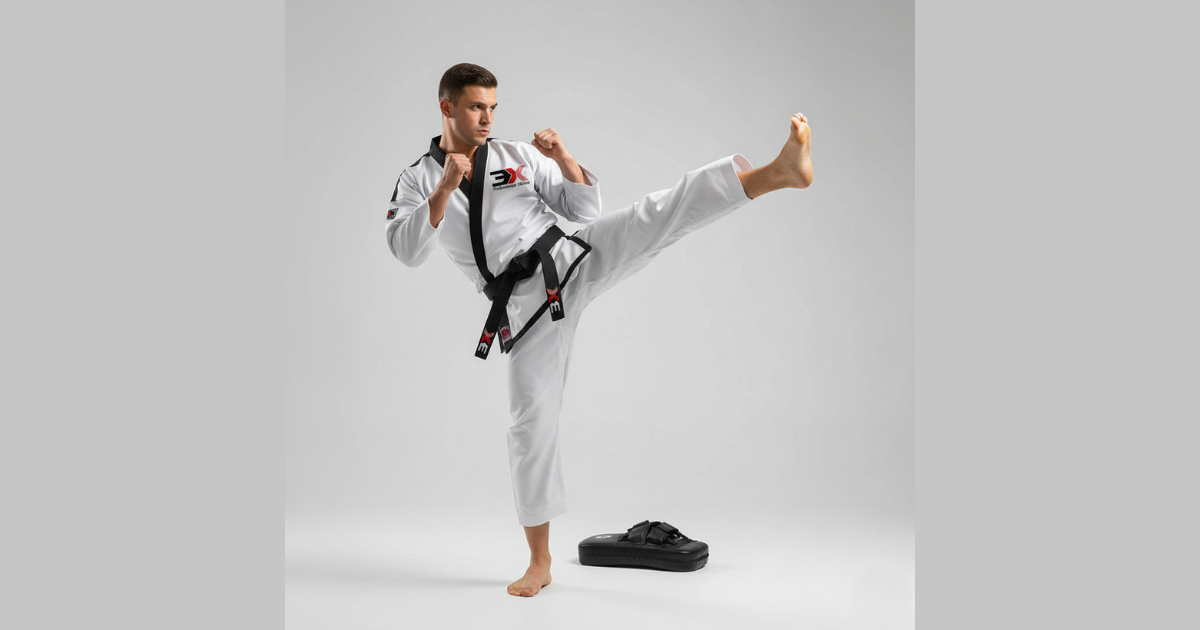Introduction: The Front Kick — A Martial Artist’s Essential Weapon
The front kick, often the first technique beginners learn and the last they truly master, is a cornerstone of nearly every striking martial art. Whether you practice karate, taekwondo, or Muay Thai, mastering this technique means achieving the perfect balance between power, speed, and accuracy. It’s not just about lifting your leg and striking forward — it’s about understanding biomechanics, timing, and control.
This guide will break down every aspect of the front kick, from the science behind its motion to advanced drills that will transform your technique. Whether you’re training for self-defense, competition, or fitness, learning how to master the front kick can dramatically elevate your martial arts skills.
Understanding the Mechanics of a Perfect Front Kick
The Science Behind the Motion
A powerful front kick relies on efficient kinetic energy transfer. The motion starts from the ground up: your supporting leg stabilizes, your core engages, and your striking leg channels the energy forward in a clean, explosive motion. Think of it as a whip — the base stays firm while the energy travels seamlessly through your body to the target.
Muscles Involved in a Front Kick
The key muscles include:
- Quadriceps – for the extension and striking motion.
- Hip flexors – to lift and chamber the knee efficiently.
- Core and lower back – for stabilization and power transfer.
- Glutes and hamstrings – to maintain balance and recoil speed.
Proper conditioning of these muscles ensures a stronger, faster, and more accurate kick.
Step-by-Step Breakdown: Executing the Front Kick Properly
Step 1: The Stance — Setting Your Foundation
Start in a balanced fighting stance. Keep your weight evenly distributed, knees slightly bent, and hands up to guard. Your stance is the foundation of your front kick — without stability, your kick loses both power and control.
Step 2: The Chamber — Coiling for Power
Lift your knee high, bringing it toward your chest. The higher your chamber, the more energy you can generate. This phase also determines the trajectory of your kick — a higher chamber helps disguise your intent and improves your range.
Step 3: The Extension — Striking with Precision
Extend your leg in a snapping or thrusting motion. The striking surface depends on your style — karate and taekwondo practitioners use the ball of the foot, while Muay Thai fighters often strike with the heel or instep. Keep your toes pulled back to protect your joints.
Step 4: The Recoil — Returning to Guard Efficiently
After impact, immediately retract your leg to the chamber position and return to your stance. The recoil prevents counterattacks and improves your balance for follow-up techniques.
Building Power in Your Front Kick
Generating power in your front kick isn’t about brute strength — it’s about coordination, muscle activation, and explosive movement.
Strength Training for Explosive Leg Power
Incorporate squats, lunges, and deadlifts into your routine. These compound movements build the foundation for a stronger kick. Add isometric holds and weighted kicks for martial-specific strength.
Plyometrics and Balance Drills for Martial Artists
Plyometric exercises like box jumps and single-leg hops train your fast-twitch muscles, improving both reaction and explosive kicking speed. Balance drills using a BOSU ball or balance board enhance stability during execution.
Breathing and Core Engagement Techniques
Your core acts as the control center for every kick. Practice exhaling sharply during your strike to engage the core muscles fully, maximizing both impact and efficiency.
Increasing Speed and Reaction Time
Speed separates an average front kick from a truly dangerous one. Martial artists who move faster can strike first, evade counters, and control the rhythm of a fight.
Speed Drills to Improve Kick Velocity
Perform shadow kicks with high repetition, focusing on minimizing unnecessary motion. Use interval training — short bursts of high-speed kicks followed by rest — to simulate real combat intensity.
Shadow Kicking and Resistance Band Training
Attach a resistance band to your ankle to build resistance during the extension phase. Over time, this strengthens your hip flexors and boosts your acceleration.
Enhancing Accuracy and Control
Accuracy in a front kick determines whether you land a clean strike or waste valuable energy. Precision comes from repetition, body awareness, and mental focus.
Target Practice and Precision Kicking Exercises
Use focus pads, kick shields, or hanging targets to train your aim. Start slow, targeting specific areas like the solar plexus, chin, or thigh. As your accuracy improves, increase speed and intensity.
Try “target line” drills, where you mark a spot on a wall or bag and attempt to strike that exact point ten times in a row without deviation. This simple yet effective routine sharpens both alignment and coordination.
Mind-Muscle Connection and Focus Drills
Your brain and muscles must work together seamlessly. Visualization helps — imagine the trajectory and impact before you kick. Breathing plays a crucial role, too: inhale to chamber, exhale to strike. Over time, this synchronization boosts consistency and precision.
Common Mistakes When Performing a Front Kick
Even experienced martial artists fall prey to small errors that reduce the front kick’s effectiveness.
Overextending or Telegraphing Your Kick
Beginners often swing their leg too far back or wind up excessively before kicking. This “telegraphs” your move, giving your opponent time to counter. Keep your motion compact and explosive — the less warning you give, the better.
Poor Balance or Weak Recovery
Failing to recoil your leg or losing balance after striking can leave you open to attacks. Always practice returning to your stance swiftly. Strengthening your core and supporting leg will drastically improve stability.
Advanced Front Kick Variations for Martial Artists
Once you’ve mastered the fundamentals, experimenting with advanced variations can enhance your versatility and control.
Jump Front Kick
This variation adds a vertical leap before striking, increasing range and power. It’s often used in demonstrations and competitions, but it’s also effective in sparring when timed perfectly.
Sliding Front Kick
Ideal for closing distance quickly, the sliding front kick involves a short shuffle forward before execution. It maintains speed and surprise while delivering a strong impact.
Double Front Kick
Used primarily in taekwondo, this technique involves delivering two rapid kicks — one low, one high — in a single motion. It tests both your stamina and precision, making it a great drill for advanced practitioners.
Front Kick Applications in Different Martial Arts Styles
While the front kick is universal, its interpretation varies across martial arts.
Karate’s Mae Geri
In traditional karate, the Mae Geri emphasizes precision and snap. Practitioners use the ball of the foot to deliver sharp, linear strikes targeting the torso or chin.
Taekwondo’s Ap Chagi
The taekwondo Ap Chagi is faster and higher, often used for scoring points in tournaments. Its power lies in the speed of execution rather than brute force.
Muay Thai’s Teep Kick
Known as the Teep, this version focuses on thrusting power and control. Fighters use it to maintain distance, disrupt rhythm, or push opponents off balance. The heel or entire sole is the striking surface for maximum push force.
Safety and Injury Prevention Tips
Mastering the front kick safely ensures longevity in training and prevents unnecessary strain or injury.
Warm-Up and Stretching Routines
Always start with dynamic stretches focusing on the hips, hamstrings, and quadriceps. Incorporate light jogging or jump rope to increase blood flow before kicking drills.
Recommended stretches:
- Hip Circles – loosen up hip joints.
- Leg Swings – improve range of motion.
- Knee-to-Chest Stretch – enhances flexibility for chambering.
Proper Recovery and Rest Practices
Post-training recovery is vital. Use foam rolling, light stretching, and adequate hydration to reduce muscle tension. Include rest days to allow for proper muscle repair and growth.
Equipment and Gear to Improve Front Kick Training
The right tools can accelerate your progress and refine your technique.
Kick Shields, Pads, and Heavy Bags
A heavy bag allows you to test both power and accuracy under resistance. Focus pads and shields help train timing and precision with a partner. Rotate between them to target different aspects of your training.
Resistance Bands and Balance Boards
Resistance bands are perfect for building explosive hip strength, while balance boards develop stability and core engagement. These tools also simulate the instability of real combat conditions, improving adaptability.
FAQs: How to Master the Front Kick
1. How long does it take to master the front kick?
It depends on your consistency and background. Beginners can achieve solid technique in 3–6 months with regular practice, while mastery may take years of refinement.
2. What’s the best striking surface for a front kick?
For karate and taekwondo, use the ball of your foot. In Muay Thai or kickboxing, the heel or sole is more effective for thrusting power.
3. How can I generate more power in my front kick?
Focus on core engagement, strong leg drive, and proper chambering. Exercises like squats, lunges, and plyometric jumps can help build explosive power.
4. Why does my balance feel off during front kicks?
Weak stabilizing muscles or poor posture may be the cause. Strengthen your support leg and core muscles, and practice balance drills regularly.
5. Should I snap or thrust my front kick?
It depends on your style. Karate typically uses a snapping motion for speed and precision, while Muay Thai and kickboxing prefer a thrusting motion for power and distance control.
6. How can I train front kicks at home?
Use a wall or chair for balance and perform slow, controlled repetitions. Shadow kick in front of a mirror to perfect your form and alignment.
Conclusion: The Path to Front Kick Mastery
Mastering the front kick is a lifelong pursuit that combines discipline, patience, and intelligent training. By focusing on the mechanics, developing power and speed, and enhancing accuracy, you’ll turn a simple strike into a weapon of precision and control.
Remember: even the most advanced martial artists continually refine their basics. The front kick may seem simple, but in its simplicity lies its depth. Train smart, stay consistent, and your kick will become faster, stronger, and sharper than ever before. For additional training resources, visit Martial Arts World.

